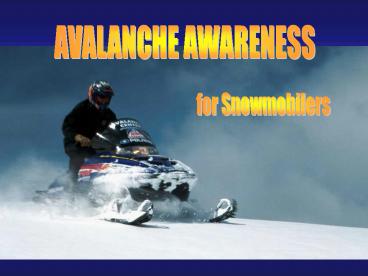AVALANCHE AWARENESS - PowerPoint PPT Presentation
1 / 90
Title:
AVALANCHE AWARENESS
Description:
... as possible on initial passes by riding low and fast and not getting stuck. ... Carry rescue gear on you and know how to use it. 87. Putting it all together... – PowerPoint PPT presentation
Number of Views:185
Avg rating:3.0/5.0
Title: AVALANCHE AWARENESS
1
AVALANCHE AWARENESS
for Snowmobilers
2
(No Transcript)
3
(No Transcript)
4
(No Transcript)
5
U.S. Avalanche Fatalities by Activity1950/51 to
2000/01
6
U.S. Avalanche Fatalities by Activity1993/94 to
2000/01
7
(No Transcript)
8
TYPE OF RESCUE (US) 1950/51-1998/99
9
With avalanches you have three choices
- Avoid avalanche terrain
- Learn about avalanches, minimize your risks
- Roll the dice (or pull the lever!)
10
(No Transcript)
11
(No Transcript)
12
POINT RELEASE aka SLUFFS
13
SLAB AVALANCHE
Starting zone
Track
Runout zone
14
- Slab Avalanche
- Crown face
- Bed surface
- Flanks
- Stauchwall
15
(No Transcript)
16
A slab is just a cohesive mass of snow
17
Slab avalanches can propagate for long distances
18
WET SLAB
19
KEY FACTORS
- Terrain
- Weather
- Snowpack
- Human Factors
20
TERRAIN
- Is the terrain capable of producing an avalanche?
21
RECOGNIZING AVALANCHE TERRAIN
- Factors to consider
- Slope angle
- Slope size and consequences
- Slope shape
- Vegetation/trees
- Runout
- Aspect w/respect to wind
- Elevation
22
(No Transcript)
23
60 deg
Slope Angles
45 deg
30 deg
15 deg
0 deg
24
(No Transcript)
25
(No Transcript)
26
Slope Shape
convexity
concavity
27
(No Transcript)
28
Size doesnt matter
29
Vegetation damage is a sure-fire indicator of
avalanche terrain!
30
Vegetation damage is also a helpful indicator of
runout!
31
TERRAIN TRAP!!
32
(No Transcript)
33
(No Transcript)
34
(No Transcript)
35
INDEPENDENCE SLIDE, BIG TIMBER, MTFebruary 24,
2001
36
38
36
40
Trigger Point
Burial Point
37
500 FOOT FRACTURE
TRIGGER POINT
800 FOOT RUNNING DISTANCE
BURIAL
38
2 TO 3 FEET DEEP
39
CROWN FACE PROFILE
DEPTH IN INCHES
43 32 6 4 0
NEW SNOW
WIND SLAB
NEAR-SURFACE FACETS
CRUST
RELATIVE HARDNESS
40
Burial Point
41
Victim was buried 5-6 feet deep!
42
WEATHER
- Is the weather affecting the snow stability?
- Snow and Rain
- Wind
- Temperature
43
Wondering what the winter will be like?
44
More Snow Equals More Avalanches!!
45
(No Transcript)
46
(No Transcript)
47
(No Transcript)
48
(No Transcript)
49
(No Transcript)
50
(No Transcript)
51
LIONHEAD AREA, WEST YELLOWSTONE, MTApril 4, 2001
52
Victims Track
53
Crown is 6-8 feet deep
54
PATH
75 Feet
Victim
Snowmobile
55
(No Transcript)
56
BURIED 2 FEET DEEP
57
SNOWPACK
- Could the snow slide?
58
Stress vs. Strength
59
(No Transcript)
60
Surface Hoar
61
Faceted Snow
62
HENDERSON MOUNTAIN, COOKE CITY, MTFebruary 4,
1992
63
(No Transcript)
64
(No Transcript)
65
(No Transcript)
66
(No Transcript)
67
(No Transcript)
68
(No Transcript)
69
(No Transcript)
70
HUMAN FACTOR
- Are you willing to make an objective assessment
of the avalanche danger?
71
CALL YOUR LOCAL AVALANCHE CENTER
72
(No Transcript)
73
Pay Attention To OBVIOUS Signs of Instability
These include collapsing, cracking or
whumphing of the snow, and
74
Recent avalanche activity
75
Snowmobiler highmarking adjacent slope
Investigating avalanche from day before
76
Everyone is facing uphill, engines off, with
nowhere to run.
Yesterdays Slide Path
77
Investigating crowns can give you valuable
information about the snowpack!
78
Test Small Slopes
79
Poorly executed highmark
80
Descending a slope from the top is safer than
riding up from the bottom
81
Ride the slope one at a time!!
82
- 63 of snowmobile avalanche accidents occur
while highmarking - Bottom Line if youre going to highmark dont
expose more than one rider at a time on the slope
83
Dont ride up to help out your stuck buddy!!
84
CARRY RESCUE GEAR!!
Or better yetmake sure your PARTNER has rescue
gear!
85
KEY POINTS
- Ride the slope one at a time. Dont ride up to
help dig out your stuck partner. - Recent avalanches are an obvious sign of
instability, so dont play on adjacent slopes
blindly. - Test lots of small slopes on your way in and get
off the packed trail as much as you can. Get off
your machine and walk around occasionally. - Riding a slope from the top down is a safer
option than from the bottom up, because you are
facing a better direction if anything goes wrong.
86
- If the goal is to highmark then gather as much
information as possible on initial passes by
riding low and fast and not getting stuck. Turn
away from the center of the slope. - If youre at the bottom waiting your turn and
cant avoid sitting in a big runout zone, keep
your machines running and pointed away from the
slope for a fast escape. - Carry rescue gear on you and know how to use it.
87
Putting it all together
Recognize that patterns exist based on elevation,
aspect and slope angle!
88
SAFE TRAVEL
Slope angle, aspect with respect to sun and wind,
consequences, slope shape, trees, runout,
elevation, patterns of avalanche activity
89
(No Transcript)
90
Created by
- Gallatin National Forest Avalanche Center
- US Forest Service National Avalanche Center
- Photographs courtesy of
- Doug Chabot, Tom Evans, Ron Johnson, Lance
Reik,Karl - Birkeland, Bruce Tremper, Scott Schmidt, Ian
- McCammon, Don Bachman, Doug Fesler/Jill Fredston
- and CAIC.
- Special thanks to Doug and Jill for using their
- Terrain/Weather/Snowpack method from Snow Sense.































